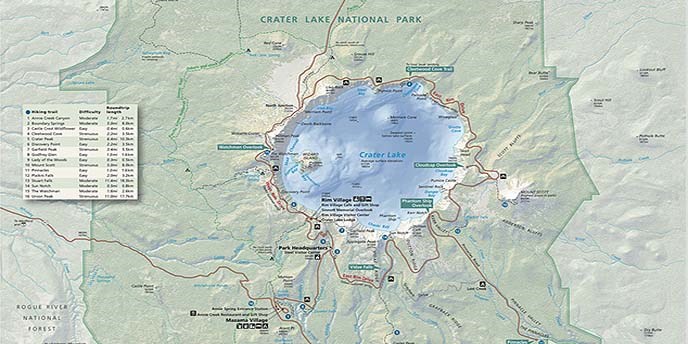Post by diane9247 on May 9, 2015 7:58:33 GMT
Crater Lake Visitors Center.kmz (770 B)
Crater Lake, the United States' deepest lake at 1,943 feet (592 meters) and the ninth deepest in the world, is the jewel of the state of Oregon. Crater Lake National Park was founded in 1902. The lake is 6 miles in diameter at its widest point and there is a rim drive that will show you just how unique this place is. Crater Lake's formation began 7,700 years ago with the eruption of Mt. Mazama and within 48 hours the massive mountain was reduced to a hollow shell. Centuries of rain and snow filled the caldera creating Crater Lake. Much of the surrounding area of Oregon contains piles of lava rock from the Mazama volcano. The water is cobalt blue, is some of the cleanest and clearest anywhere in the world, and is surrounded by steep sides, all making it a stunning sight year-round.

A warming climate change has caused several years of reduced snow pack, the 2014-2015 winter season drastically so. The mountains are receiving most of their precipitation as rain, rather than snow. Much of the park is closed between approximately mid-October to April, but unless the highway up the mountain is impassable, the visitor's center and its small cafe are open a few days per week. There are no winter accommodations, so be prepared to make this a day trip from Klamath Falls or Medford. I took these photos in Jan., 2014.


The park features a full array of activities and accommodations: campgrounds, cabins, visitor's center, several places to eat, many hiking trails and a trail leading down to the lake, where you can take a boat tour. The premier place to stay is the historic Crater Lake Lodge. The park, except the back country trails, is accessible to people with physical challenges.
The lake in summer.

"Crater Lake from Watchman Lookout" by Arcataroger - Own work. Licensed under CC BY 3.0 via Wikimedia Commons
Crater Lake, the United States' deepest lake at 1,943 feet (592 meters) and the ninth deepest in the world, is the jewel of the state of Oregon. Crater Lake National Park was founded in 1902. The lake is 6 miles in diameter at its widest point and there is a rim drive that will show you just how unique this place is. Crater Lake's formation began 7,700 years ago with the eruption of Mt. Mazama and within 48 hours the massive mountain was reduced to a hollow shell. Centuries of rain and snow filled the caldera creating Crater Lake. Much of the surrounding area of Oregon contains piles of lava rock from the Mazama volcano. The water is cobalt blue, is some of the cleanest and clearest anywhere in the world, and is surrounded by steep sides, all making it a stunning sight year-round.

A warming climate change has caused several years of reduced snow pack, the 2014-2015 winter season drastically so. The mountains are receiving most of their precipitation as rain, rather than snow. Much of the park is closed between approximately mid-October to April, but unless the highway up the mountain is impassable, the visitor's center and its small cafe are open a few days per week. There are no winter accommodations, so be prepared to make this a day trip from Klamath Falls or Medford. I took these photos in Jan., 2014.

The park features a full array of activities and accommodations: campgrounds, cabins, visitor's center, several places to eat, many hiking trails and a trail leading down to the lake, where you can take a boat tour. The premier place to stay is the historic Crater Lake Lodge. The park, except the back country trails, is accessible to people with physical challenges.
The lake in summer.

"Crater Lake from Watchman Lookout" by Arcataroger - Own work. Licensed under CC BY 3.0 via Wikimedia Commons

